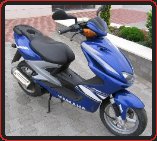| HOMEPAGE ABOUT CAREER PORTFOLIO CONTACT |

M O T O R C Y C L E S
Pocket rocket: 2003 Yamaha Aerox 100 (published Cycle Torque, February 2004)
Yamaha's mid-range scooter packs quite a punch
Sleek sporting lines. A blue and white paint job and competition graphics that speak of the marque's racing heritage. A two-stroke pocket dynamo revving all the way to 6800 rpm. Would you believe it's a scooter? Meet Yamaha's Aerox 100.
Engine and chassis
The power comes from the Aerox's air-cooled 101cc two-stroke engine. Lighter, simpler and more powerful than a four-stroke of the same capacity, it's not surprising Yamaha has opted for a two-stroke to drive its sports scooter. The downside is you have to put two-stroke oil in the separate Autolube tank and put up with the distinctive two-stroke sound and some blue smoke on start-up.
The scoot is more than capable of leaving the safety of suburbia and tackling the open road.
Learners will find the fully automatic transmission a dream. Simply twist the throttle and go, allowing the novice to focus on the traffic and road conditions rather than all of the fiddly finer points of motorcycle riding.
Large 13" wheels with Michelin tyres inspire confidence and offer outstanding handling. Our scooter was surefooted, even on the bumpiest of country roads.
Both brakes are up front, making the transition from a pushbike to the Aerox seamless. The front disc brake has plenty of stopping power while the rear drum brake provides steady even braking.
The Aerox has electric start and a kick-starter to ensure you're never caught short.
Suspension is non-adjustable, which is curious for a machine billing itself as a sports scooter. Telescopic front forks with 80 mm of travel and a single rear shock with 72 mm of travel provide adequate road handling.
Equipment and styling
The seat height is a little taller than other scooters I've ridden, which made me feel a little intimidated at first. I'm not short at 170 cm, yet I struggled to touch my toes to the ground. However the added height does offer excellent vision, and once you're moving the nerves soon fade.
Passenger grips are provided for the pillion and the seat is long and padded for comfort. However the scooter is small and performance will suffer when riding two up.
The fuel gauge is a handy feature in the dash. As a learner I would have serious troubles guessing when my fuel was low, so having the Aerox take care of it for me was another thing I didn't have to think about. Scooters offer excellent fuel economy and the Aerox is no different. You can fill up the seven-litre fuel tank after a week's riding and still receive change from a $5 note.
The instrument console also features a tachometer and we can't quite work out why. When you're riding an automatic the revs don't seem to be that important. The space taken up by the tacho makes for a smaller speedometer, which was a little difficult to read. The speedo on our test scoot also clocked at around 10 km/h faster than the actual speed (at 80 km/h).
There's no screen for weather protection, which is fine when using the bike around town but you really miss out on the open road.
As is standard with scooters, a centrestand is used rather than a side stand. When you park your scooter it's essentially in neutral, so having the scoot propped on a center stand will prevent it from rolling away. However, I found the centre stand very awkward to operate. I'm assured it's a case of technique rather than strength, but my 55 kg frame needed someone else to help me park it. One way around this was to stop the scooter on a downward slope and let its momentum help me, but this isn't always practical.
A roomy lockable compartment under the seat offers enough space for your helmet and gloves or quite a load of shopping. Lockable steering also adds peace of mind.
The verdict
The Aerox 100 offers all the easy riding of a scooter with some serious racing cred. The clutchless transmission keeps things easy and they look the business on the roads. As in Europe, I could imagine these little sports scooters having a niche market in novice riders who may use them as a stepping stone for a bigger machine. That is, if they can bear to part with them.
(c) 2006 Lauren Katulka